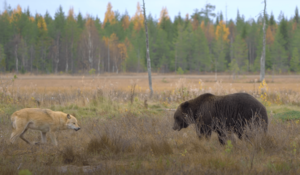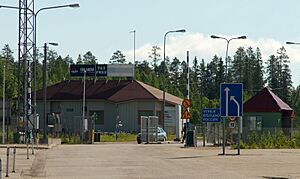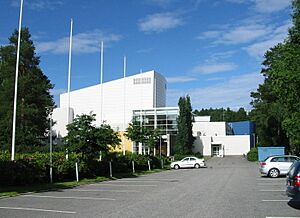Kuhmo facts for kids
Quick facts for kids
Kuhmo
|
||
|---|---|---|
|
Town
|
||
| Kuhmon kaupunki Kuhmo stad |
||
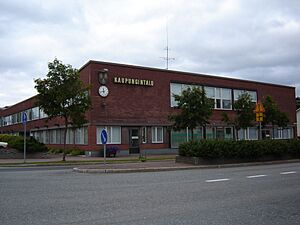
Kuhmo Town hall
|
||
|
||
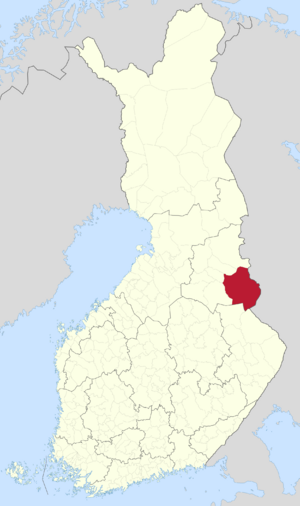 |
||
| Country | Finland | |
| Region | Kainuu | |
| Sub-region | Kehys-Kainuu | |
| Charter | 1865 | |
| City rights | 1986 | |
| Area
(2018-01-01)
|
||
| • Total | 5,456.78 km2 (2,106.87 sq mi) | |
| • Land | 4,807.07 km2 (1,856.02 sq mi) | |
| • Water | 649.97 km2 (250.95 sq mi) | |
| Area rank | 12th largest in Finland | |
| Population
(2023-12-31)
|
||
| • Total | 7,582 | |
| • Rank | 125th largest in Finland | |
| • Density | 1.58/km2 (4.1/sq mi) | |
| • Finnish | 97.1% (official) | |
| • Swedish | 0.1% | |
| • Others | 2.8% | |
| Population by age | ||
| • 0 to 14 | 10.8% | |
| • 15 to 64 | 51.5% | |
| • 65 or older | 37.6% | |
| Time zone | UTC+02:00 (EET) | |
| • Summer (DST) | UTC+03:00 (EEST) | |
Kuhmo (called Kuhmoniemi until 1937) is a town and a municipality in Finland. It is located in the southeastern part of the Kainuu region.
Kuhmo has a population of about 7,582 people (as of 31 December 2023). The total area is around 5,456.78 square kilometres (2,106.87 sq mi), with 649.97 km2 (250.95 sq mi) of that being water. This means there are about 1.58 inhabitants per square kilometre (4.1/sq mi) people per square kilometer.
Kuhmo shares a long border of 120 kilometres (75 mi) with Russia. Nearby towns in Finland include Hyrynsalmi, Lieksa, Nurmes, Ristijärvi, Sotkamo, and Suomussalmi. Across the Russian border is the city of Kostomuksha. Vartius, an important border crossing point between Finland and Russia, is in northern Kuhmo.
The eastern border of Kuhmo is a natural water divide. This means that rivers on one side flow in a different direction than rivers on the other side. The town's area is part of the Oulujärvi lake system. The official language in Kuhmo is Finnish.
Contents
History of Kuhmo
The first people arrived in Kuhmo after the last ice age, around 8000 BCE. Evidence of Stone Age homes has been found near Ontojärvi and Lammasjärvi lakes. The Sami people lived in the Kuhmo area until new settlers from Karelia and Savonia moved them further north. You can still see the influence of Sami culture in some place names. Wide waterways attracted hunters, traders, and tax collectors as early as the 9th century.
In 1323, the Treaty of Nöteborg was signed between Sweden and the Novgorod Republic. This treaty placed the Kuhmo area under Novgorod's control. However, people from the west continued to hunt and collect taxes there. Sweden wanted to move the border further east.
People began to settle permanently in the area after Gustav I, the king of Sweden, promised tax breaks to farmers who moved north. Sadly, almost all settlements were destroyed during the war between Russia and Sweden from 1570 to 1595. After the Treaty of Teusina, Kuhmo became part of Sweden. For centuries, this area faced many attacks during various wars.
In 1809, Finland became part of the Russian Empire as the Grand Duchy of Finland. Kuhmo became a trade route for merchants from Karelia and Russia. To remember these traders, there is a statue called “Laukunkantaja” (meaning "The Bag Bearer") in Kuhmo's market square. During this time, Elias Lönnrot, who put together the Finnish National Epic Kalevala, traveled through Kuhmo to Karelia to collect poems. Lönnrot even did some of his editing in Kuhmo. You can see a rebuilt hut where he stayed in the Kalevala village. The publishing of Kalevala in 1835 led to the rise of Karelianism, a cultural movement. Akseli Gallen-Kallela, a famous Finnish artist and a founder of Karelianism, spent his honeymoon in Kuhmo. He painted some of his works at Lapinsalmi, near Lake Lentua. The scenery of Lake Lentua was the background for the middle part of his famous painting, Aino triptych.
During the 19th century, slash-and-burn farming was still important but was slowly declining. By the late 1700s, tar production became a new and growing way to earn money. In 1900, Kuhmo produced the most tar in Finland, about 1.6 million liters. Tar was shipped from Kuhmo to Oulu using large rowboats. The biggest boats could carry 25 to 27 barrels, each holding 125 liters. You can still find remains of tar pits, where tar was made from pine trees, all over the Kuhmo area.
The village of Jonkeri and its nearby areas were moved from Nurmeksen maalaiskunta to Kuhmo in 1903.
The Winter War was a very important event for Kuhmo. During the war, Kuhmo was bombed 48 times. Ground battles happened as close as ten kilometers from the town center. The Soviet army wanted to go through Kuhmo and Kajaani to reach Oulu and split Finland in two. However, the Finnish forces stopped them on the Kuhmo – Saunajärvi road at Jyrkänkoski and on the Kuhmo – Kiekinkoski road at Tyrävaara. Both battle sites are about 10 km from the town center. The Soviet 54th Division had to spread out its troops, which made Finnish guerrilla tactics very effective. After being stopped, Soviet forces were divided and surrounded in small pockets. The fight to destroy these pockets continued until the Moscow Peace Treaty. After the war, Kuhmo's eastern border stayed the same, meaning it has had the same border for 400 years since the Treaty of Teusina in 1595.
Geography and Nature
Kuhmo is the second largest municipality in the Kainuu region by area. It is also the twelfth largest in Finland. Its land area is twice the size of Luxembourg. Most of the people live in Kuhmo town.
Most of the area is very wild, with over 600 lakes. The rest is covered in thick forests. This provides a home for many wild animals, including brown bears, wolves, and Finnish forest reindeer.
The Ministry of Agriculture and Forestry has named Kuhmo as part of Eastern Finland's main bear population area. This means they plan to keep the bear population denser here than in other parts of the country. The wolf population is also quite large compared to the rest of Finland. Because of this, the number of reindeer has recently gone down.
The land in Kuhmo has low hills. The most important ones are near the Russian border on the eastern side. To the south, Kuhmo borders North Karelia.
Several nature reserves have been created in Kuhmo to protect the wild frontier areas. The Forest administration maintains many hiking trails in these reserves, and most are open to the public.
Districts and Villages
Districts:
- Akonlahti
- Hankaranta
- Jaurakko
- Kalevala
- Kanninlampi
- Kantola
- Keitaala
- Kontio
- Korkeamäki
- Kuhmoniemi
- Levälahti
- Pajakka
- Piilola
- Saarikoski
- Sormula
- Suvanto
Villages:
- Haukela
- Hietaperä
- Härmänkylä
- Hukkajärvi
- Iivantiira
- Jonkeri
- Juonto
- Juttua
- Jyrkkä
- Jämäs
- Kalliojoki
- Katerma
- Kattilakoski
- Kiekinkoski
- Kivikiekki
- Korpisalmi
- Kuumu
- Kuusamonkylä
- Lammasperä
- Lauvuskylä
- Lentiira
- Lentua
- Niemiskylä
- Niva
- Saunajärvi
- Timoniemi
- Rasti
- Seilonen
- Sylväjä
- Vartius
- Vepsä
- Vieksi
- Viiksimo
- Vuosanka
- Ypykkävaara
Rimpi Village
Rimpi is a former village close to the Russian border. Today, it is officially part of Vartius. Traditionally, Karelian Orthodox Christians lived in Rimpi. It was one of three Karelian-speaking villages in Kainuu. The other two were Kuivajärvi and Hietajärvi in Suomussalmi.
The village was destroyed during the Winter War and later rebuilt. However, Finnish authorities did not allow people to build Karelian-style houses. By the early 1980s, no one lived there permanently. New people moved there permanently in 1991.
Eljas Ahtonen, who was the model for Väinämöinen in Akseli Gallen-Kallela's painting Aino-taru, was from Rimpi.
Culture
Kuhmo is famous for its Kuhmo Chamber Music Festival. This festival happens every year. It was started in 1970 by cellist Seppo Kimanen and some friends. A book about the festival was published in 2006.
Places to Visit
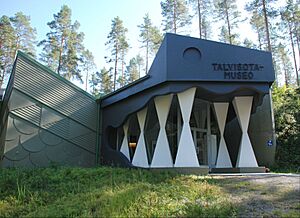
- Kuhmo Arts Centre
- Kalevala Village
- Juminkeko – The Information Center for the Kalevala and Karelian Culture.
- Petola Visitor Centre
Notable People
- Johan Gabriel Ståhlberg (1832–1873), a Finnish priest and the father of President K. J. Ståhlberg
International Connections
Twin Towns and Sister Cities
Kuhmo has special connections with these towns:
 Kostamus, Russia
Kostamus, Russia Oroszlány, Hungary
Oroszlány, Hungary Robertsfors, Sweden
Robertsfors, Sweden Šaľa, Slovakia
Šaľa, Slovakia
See also
 In Spanish: Kuhmo para niños
In Spanish: Kuhmo para niños



